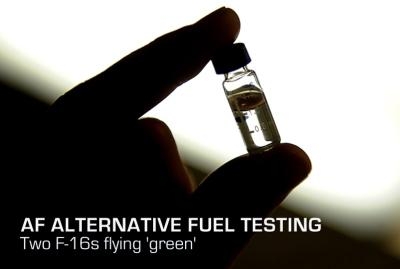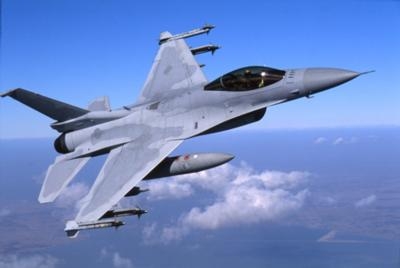Biofuel Research Continuing On Fighting Falcon
In a joint effort by Airmen from the Air Force Research
Laboratory at Wright-Patterson Air Force Base, OH, and Airmen from
the Ohio Air National Guard's 180th Fighter Wing, the F-16 Fight
Falcon is currently undergoing a field service evaluation of
biofuel. As the largest consumer of energy in the Defense
Department and $8 billion spent on fuel in fiscal 2011, Air Force
officials are working toward making the fleet a little "greener" by
researching, testing and ultimately implementing the use of
alternative fuels.

Although other airframes, such as the C-17 Globemaster III, have
been certified to use biofuel for unrestricted operations, this is
the first evaluation of the F-16 Fighting Falcon. Two F-16s from
the 180th FW fleet have been designated to test the 50/50 blend of
Jet Propellant-8 petroleum and Hydroprocessed Renewable Jet fuel
derived from the camelina plant. Camelina is essentially a weed
that grows throughout the United States and requires very little
horticulture.
The 180th FW was an ideal location for the fuel test because of its
proximity to Wright-Patterson AFB, where the Air Force Research
Laboratory is located, and its continued focus on green energy. In
2011, the wing was awarded the Reduced Energy Appreciation Program
Award by the Air Force Civil Engineer Support Agency's Air Force
Facility Energy Center. "It's part of the Air Force's strategic
goals to be able to reduce energy across the Air Force, so we
really embrace that," said Col. Steve Nordhaus, the 180th FW
commander. "We're trying to do everything we can to reduce energy
costs because we know that every dollar we save there, we can use
to buy more aircraft that protect our country or help support
Airmen who are out there doing critical missions that affect our
homeland defense."
The jets have been flying with the blend since mid-December and
will continue until the test sample is depleted. "Our ability to
exercise and use this stuff on a small scale or case-by-case basis
makes us ideally suited to test the fuel," said Col. William Gieze,
the 180th Mission Support Group commander.
The staff at AFRL worked with commercial fuel manufacturers to
develop a blend that would meet Air Force specifications.
Considerations such as the flash and freeze points of the fuel were
some of the major factors when determining the specifications for
the F-16. "Manufacturers are making alternative fuels for both the
military and commercial customers," said Dr. Tim Edwards, a senior
chemical engineer for the AFRL fuels division. "Typically, they'll
send samples of their fuel, and we'll evaluate and say, 'Yes,
you're on the right track, this could be a jet fuel.' When they get
to the point where they can make large enough quantities, we'll
hand them over them off to the Alternative Fuels Certification
office."
F-16 File Photo

The Air Force goal, by 2016, is to have half of the fuel that is
purchased domestically to be at least a 50/50 blend of conventional
and alternative fuel, Edwards said.
Another goal for the researchers and developers was to make the
transition as seamless as possible. To date, there has been no
additional training, equipment or maintenance required to begin
using the fuel. "When we first started this we were a little
concerned because a few years ago we made the switch from JP4 to
JP8 jet fuel," said Col. Scott Reed, the 180th Maintenance Group
commander. "The difference between the two caused a few hiccups
initially. Some of the gaskets and O-rings didn't expand as they
normally would in the presence of the fuel, so we had leaks."
The colonel likened the process to driving a car from Los Angeles
at sea level to the Rocky Mountains. Adjustments need to be made
for the car to operate at peak performance at different elevations.
But with the new fuel blend, the transition has been totally
transparent. After each flight, the pilots complete a debrief form
and each week the fuels technicians complete a debrief form to
provide data to the Alternative Fuels Certification office about
how the jets are performing with the new fuel blend. And just as in
real world operations, the jets designated for the test can refuel
from the same tanker as the rest of their fleet during mission.
Since biofuels may not be available at every base, or some overseas
locations, the fuel blend must be interchangeable with standard
JP-8. "The truth of it is there has been absolutely no noticeable
difference whatsoever," Reed said. "There have been no fuel leaks,
no operational impact."
Once all of the data is collected and analyzed and any issues are
rectified, the fuel can be certified to be used for all F-16s. "The
fact that we're going to be doing something that not only affects
the Air National Guard, but the total force was really our end
goal," Gieze said. "We really want to see the F-16 get certified on
this and allow our country some other avenues for fuel."
 Unfortunate... ANN/SportPlane Resource Guide Adds To Cautionary Advisories
Unfortunate... ANN/SportPlane Resource Guide Adds To Cautionary Advisories ANN FAQ: Turn On Post Notifications
ANN FAQ: Turn On Post Notifications ANN's Daily Aero-Term (04.29.24): Visual Approach Slope Indicator (VASI)
ANN's Daily Aero-Term (04.29.24): Visual Approach Slope Indicator (VASI) ANN's Daily Aero-Term (04.28.24): Airport Marking Aids
ANN's Daily Aero-Term (04.28.24): Airport Marking Aids ANN's Daily Aero-Linx (04.28.24)
ANN's Daily Aero-Linx (04.28.24)




